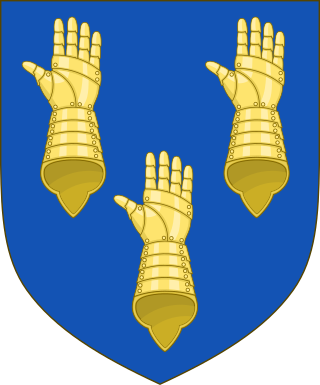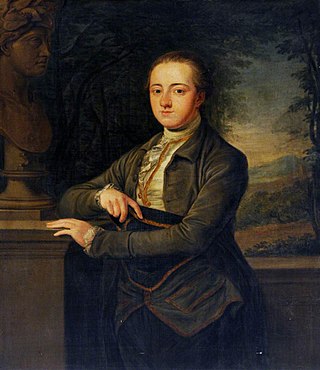
Augustus Henry FitzRoy, 3rd Duke of Grafton,, styled Earl of Euston between 1747 and 1757, was a British Whig statesman of the Georgian era. He is one of a handful of dukes who have served as prime minister.

Duke of Beaufort is a title in the Peerage of England. It was created by Charles II in 1682 for Henry Somerset, 3rd Marquess of Worcester, a descendant of Charles Somerset, 1st Earl of Worcester, legitimised son of Henry Beaufort, 3rd Duke of Somerset, a Lancastrian leader in the Wars of the Roses. The name Beaufort refers to a castle in Champagne, France. It is the only current dukedom to take its name from a place outside the British Isles.

Duke of Grafton is a title in the Peerage of England. It was created in 1675 by Charles II of England for Henry FitzRoy, his second illegitimate son by the Duchess of Cleveland. The most notable duke of Grafton was Augustus FitzRoy, 3rd Duke of Grafton, who served as Prime Minister from 1768–1770.

Duke of St Albans is a title in the Peerage of England. It was created in 1684 for Charles Beauclerk, 1st Earl of Burford, then 14 years old. King Charles II had accepted that Burford was his illegitimate son by Nell Gwyn, an actress, and awarded him the dukedom just as he had conferred those of Monmouth, Southampton, Grafton, Northumberland, and Richmond and Lennox on his other illegitimate sons who married.

Earl of Cardigan is a title in the Peerage of England, currently held by the Marquesses of Ailesbury, and used as a courtesy title by the heir apparent to that Marquessate, currently David Brudenell-Bruce, Earl of Cardigan, son of the 8th Marquess. The Brudenell family descends from Sir Robert Brudenell, Chief Justice of the Common Pleas from 1520 to 1530. His great-grandson, Sir Thomas Brudenell, was created a Baronet in the Baronetage of England, styled "of Deene in the County of Northampton", on 29 June 1611. On 26 February 1628, he was raised to the Peerage of England as Baron Brudenell, of Stanton Wyvill in the County of Leicester, and on 20 April 1661 he was further honoured when he was made Earl of Cardigan, also in the Peerage of England. On his death, the titles passed to his son, Robert, the 2nd Earl, and on the 2nd Earl's death to his grandson, George, the 3rd Earl, the 2nd Earl's only son, Francis, Lord Brudenell, having predeceased his father.

Baron Willoughby de Eresby is a title in the Peerage of England. It was created in 1313 for Robert de Willoughby. Since 1983, the title has been held by Jane Heathcote-Drummond-Willoughby, 28th Baroness Willoughby de Eresby.

Baron Barnard, of Barnard Castle in the Bishopric of Durham, is a title in the Peerage of England. It was created in 1698 for Christopher Vane, who had previously served as a member of parliament for County Durham and Boroughbridge. Vane was the son of Sir Henry Vane the Younger and grandson of Sir Henry Vane the Elder. His grandson, the third Baron, notably served as Paymaster of the Forces and as Lord Lieutenant of County Durham. In 1754 he was created Viscount Barnard and Earl of Darlington, both in the County Palatine of Durham. Lord Darlington was the husband of Lady Grace FitzRoy, daughter of Charles FitzRoy, 2nd Duke of Cleveland, the illegitimate son of King Charles II by his mistress Barbara Villiers, 1st Duchess of Cleveland.
Baron Arlington is a title in the Peerage of England which was created, on 14 March 1665, for Sir Henry Bennet, younger brother of John Bennet, 1st Baron Ossulston. In 1672, he was made Earl of Arlington and Viscount Thetford, and was regranted the title of Baron Arlington, with a special remainder allowing it to pass to both male and female descendants, rather than only heirs male, as was customary with most peerages. Its territorial designation is the birthplace of its first holder Harlington, London, which was also known as Arlington.

Viscount Daventry, of Daventry in the County of Northampton, is a title in the Peerage of the United Kingdom. It was created on 6 May 1943 for Muriel FitzRoy, in honour of her late husband, the Hon. Edward FitzRoy, Speaker of the House of Commons from 1928 until his death in 1943. The first Viscountess was the sister of Frank Douglas-Pennant, 5th Baron Penrhyn, whilst Edward FitzRoy was the second son of Charles FitzRoy, 3rd Baron Southampton, and a male-line descendant of Charles FitzRoy, 2nd Duke of Grafton. Lady Daventry was succeeded by her eldest son, the second Viscount. He was a captain in the Royal Navy. He was succeeded by his nephew, the third Viscount. His father had assumed the additional surname of Newdegate, which was that of his father-in-law. As of 2017 the title is held by his son, the fourth Viscount, who succeeded in 2000. As a male-line descendant of both the third Baron Southampton and the second Duke of Grafton, he is also in remainder to those peerages.

Duke of Cleveland was a title that was created twice, once in the Peerage of England and once in the Peerage of the United Kingdom. The dukedoms were named after Cleveland in northern England.
Charles FitzRoy may refer to:

Earl of Munster is a title that was created twice, once in the Peerage of Ireland and once in the Peerage of the United Kingdom. The first creation came in 1789 in favour of Prince William, the third son of King George III. He was made Duke of Clarence and St Andrews at the same time. When William succeeded to the throne as King William IV in 1830 the titles merged with the crown.
Fitzroy or FitzRoy may refer to:

Augustus Charles Lennox FitzRoy, 7th Duke of Grafton, styled Lord Augustus FitzRoy before 1882, was a British Army officer. He was the second son of Henry FitzRoy, 5th Duke of Grafton, and his wife Mary Caroline Cranfield Berkeley, daughter of Admiral the Hon. Sir George Cranfield Berkeley.

George Cavendish, 1st Earl of Burlington, styled Lord George Cavendish before 1831, was a British nobleman and politician. He built Burlington Arcade.

General Charles FitzRoy, 1st Baron Southampton was a British Army officer who served in the Seven Years' War and a politician who sat in the House of Commons from 1759 to 1780. The second son of Lord Augustus FitzRoy, FitzRoy joined the 1st Foot Guards as an ensign in 1752 and was promoted to lieutenant-colonel in 1758. In the following year he fought at the Battle of Minden as an aide de camp, where he was a part of the controversy surrounding Lord George Sackville's slow reaction to orders sent to him. FitzRoy was also present at the Battle of Vellinghausen in 1761. Having been quickly promoted through the ranks with the support of his powerful family, he was promoted to major-general in 1772 and became a general in 1793.
General Lord Charles FitzRoy was a British Army officer and politician.
Charles FitzRoy, 3rd Baron Southampton was a British peer.

Ismania Catherine FitzRoy, Baroness Southampton was an Irish aristocrat, the wife of Charles FitzRoy, 3rd Baron Southampton. She served as Lady of the Bedchamber to Queen Victoria.
Francis George Spencer, 2nd Baron Churchill,, was a British peer and diplomat from the Spencer family.













